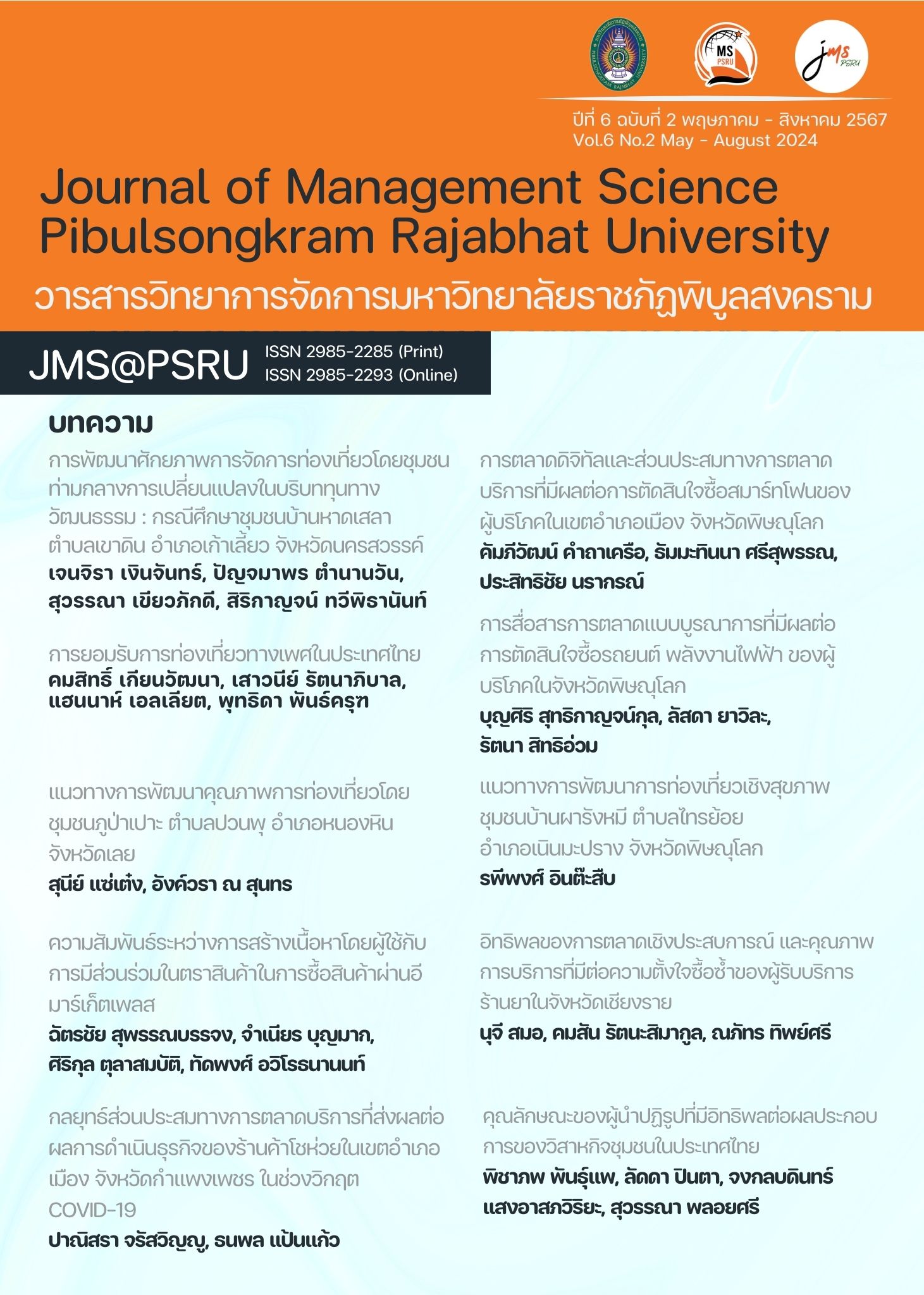Community-Based Tourism Capacity Development amidst Cultural Capital Transformation: a Case Study of Had-Salaow Village, Kaodin Subdistrict, Kao Liao District, Nakhon Sawan Province.
Keywords:
Management, community-based tourism, cultural capitalAbstract
The objective of this study was to examine the cultural context of community resources in Had-Salaow Village, Kaodin Subdistrict, Nakhon Sawan Province in order to develop the potential for community-based tourism management. The research used qualitative research techniques, including interviews and field observations. The main 15 data providers consisted of government officials, business operators, community leaders, and community managers. The research findings revealed that the cultural context of Had-Salaow Village encompassed various cultural heritages, including Thai, Yuan, Mon, Thai Song Dam, Christian, and Chinese cultures, coexisting along the path of simplicity and cultural integration. In terms of developing the potential for community-based tourism management, community-driven tourism initiatives were propelled by the principles of self-sufficiency economics and the BCG Model, aiming to align cultural resources with the needs of tourists and create value for the community's culture. The community had strengths in diverse tourism attractions, including cultural and agricultural aspects, as well as the synergy between community members and local organizations. However, there were weaknesses in terms of tourism management structure and clear guidelines for tourism administration. To enhance the capacity for community-based tourism management in Had-Salaow Village, it is necessary to establish clear and equitable responsibilities for tourism stakeholders, emphasizing collaboration between the community and relevant organizations to drive tourism development in a unified direction. This can be achieved through policy-level understanding and communication, the establishment of network partnerships, and the promotion of utilizing the community's cultural resources to create economically sustainable tourism activities for community development.
References
ณัฐชา ลี้ปัญญาพร และปริญญา หรุ่นโพธิ์. (2564). การศึกษาทุนทางวัฒนธรรมชาติพันธุ์ลาวครั่ง ในมิติการท่องเที่ยวเชิงวัฒนธรรม เพื่อยกระดับเศรษฐกิจชุมชนบ้านทุ่งสีหลง อำเภอดอนตูม จังหวัดนครปฐม. วารสารวิจัยและพัฒนา มหาวิทยาลัยราชภัฏสวนสุนันทา, 13(2), 176-195.
ปรัชญากรณ์ ไชยคช. (2565). การศึกษาเพื่อยกระดับระบบการจัดการการท่องเที่ยวโดยชุมชนของประเทศไทยสู่ความยั่งยืน (รายงานวิจัย). สงขลา: มหาวิทยาลัยสงขลานครินทร์.
ปิรันธ์ ชิณโชติ, และธีระวัฒน์ จันทึก. (2559). รูปแบบการจัดการการท่องเที่ยวเชิงสร้างสรรค์ของสวนผึ้ง.วารสารอิเล็กทรอนิกส์ Veridian มหาวิทยาลัยศิลปากร (มนุษยศาสตร์สังคมศาสตร์และศิลปะ), 9(1), 252-253.
พจนา สวนศรี. (2546). คู่มือการจัดการท่องเที่ยวโดยชุมชน. กรุงเทพฯ: โครงการท่องเที่ยวเพื่อชีวิต และธรรมชาติ.
พจนา สวนศรี และสมภพ ยี่จอหอ. (2556). คู่มือมาตรฐานการท่องเที่ยวโดยชุมชน. สถาบันการท่องเที่ยวโดยชุมชน มหาวิทยาลัยพายัพ จังหวัดเชียงใหม่ (พิมพ์ครั้งที่ 1). เชียงใหม่: วนิดาการพิมพ์.
ภาวณา เขมะรัตน์. (2550). บทวิจารณ์และแนะนำหนังสือ. วารสารพัฒนบริหารศาสตร์, 47(1), 195-196.
สุภาภรณ์ ประสงค์ทัน. (2556). ทุนทางสังคมกับแนวทางการส่งเสริมการท่องเที่ยวโดยชุมชนเชิงสร้างสรรค์: กรณีศึกษาชาวไทยพวน อ.ปากพลี จ.นครนายก. วารสารสังคมศาสตร์ มหาวิทยาลัยศรีนครินทร วิโรฒ, 16, 225-235.
สำนักงานคณะกรรมการพัฒนาการเศรษฐกิจและสังคมแห่งชาติ. (2564). ยุทธศาสตร์ชาติ. สืบค้นเมื่อ 19 กุมภาพันธ์ 2566. จาก http://nscr.nesdc.go.th/wp-content/uploads/2019/04/05-การท่องเที่ยว.pdf
สำนักงานพัฒนาชุมชนจังหวัดนครสวรรค์. (2563). โครงการพัฒนาศักยภาพชุมชนท่องเที่ยว OTOP นวัตวิถี พัฒนาศักยภาพผู้ประกอบการเพื่อส่งเสริมการท่องเที่ยวชุมชนบ้านหาดเสลา จังหวัดนครสวรรค์. สืบค้นเมื่อ 3 กุมภาพันธ์ 2566. จาก https://anyflip.com/cyycc/pyoo/basic.
สำนักงานสภานโยบายการอุดมศึกษา วิทยาศาสตร์ วิจัยและนวัตกรรมแห่งชาติ. (2563). โมเดลเศรษฐกิจ บีซีจี. สำนักงานสภานโยบายการอุดมศึกษาวิทยาศาสตร์วิจัยและนวัตกรรมแห่งชาติ. สิบค้นเมื่อ 23 กุมภาพันธ์ 2566. จาก https://www.nxpo.or.th/th/bcg-economy/
องค์การบริหารการพัฒนาพื้นที่พิเศษเพื่อการท่องเที่ยวอย่างยั่งยืน (องค์การมหาชน). (2561). การท่องเที่ยวโดยชุมชนวิถีไทย เก๋ไก๋อย่างยั่งยืน. สืบค้นเมื่อ 16 มีนาคม 2566. จาก https://tatreviewmagazine.com/article/cbt-thailand/
Bourdieu, P. (1986). The forms of capital. In J. Richardson (Ed.) Handbook of Theory and Research for the Sociology of Education. New York: Greenwood Press.
Patmasiriwat, D. (2004). A survey of the status of knowledge and the development of cultural capital and local knowledge to human resource development: progress report of the first study. Phitsanulok, Naresuan University.
Samudavanija, C. (1997). Cultural as capital. Bangkok: p. Press.
Throsby, C. D. (2001). Economics and culture. Cambriกdge: Cambridge University Press.
Downloads
Published
How to Cite
Issue
Section
License
Copyright (c) 2024 Faculty of Management Science Pibulsongkram Rajabhat University

This work is licensed under a Creative Commons Attribution-NonCommercial-NoDerivatives 4.0 International License.
บทความที่ได้รับการตีพิมพ์ในวารสารวิทยาการจัดการมหาวิทยาลัยราชภัฏพิบูลสงคราม เป็นลิขสิทธิ์ของมหาวิทยาลัยราชภัฎพิบูลสงคราม
บทความที่ลงพิมพ์ใน วารสารวิทยาการจัดการมหาวิทยาลัยราชภัฎพิบูลสงคราม ถือว่าเป็นความเห็นส่วนตัวของผู้เขียนคณะบรรณาธิการไม่จำเป็นต้องเห็นด้วย ผู้เขียนต้องรับผิดชอบต่อบทความของตนเอง



